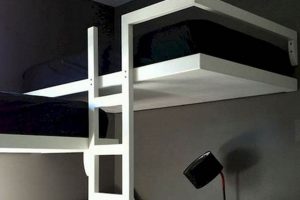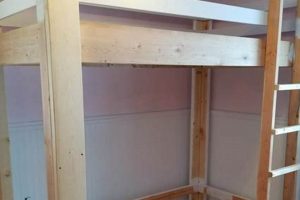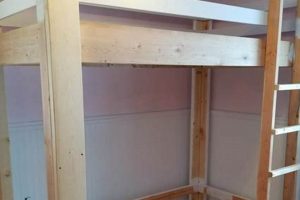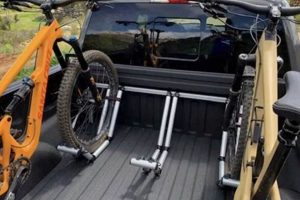A custom-built partition for the cargo area of a pickup truck, constructed from polyvinyl chloride pipes and fittings, created by the owner rather than purchased pre-made, is a practical solution for organizing and securing items within the truck bed. This structure typically utilizes standard PVC piping, connectors, and fasteners to create a frame that separates the bed into distinct compartments, preventing items from shifting during transit. As an example, a user might construct a framework to isolate groceries from tools, preventing potential damage or contamination.
The significance of such a build lies in its potential for cost savings and customization. Factory-made truck bed organization systems can be expensive. Fabricating one from readily available PVC components presents a more economical alternative. Furthermore, the design can be tailored precisely to the specific dimensions of the truck bed and the unique needs of the owner, optimizing space utilization and improving the overall functionality of the vehicle. Historically, individuals have sought ways to better manage truck bed space, leading to the evolution of various aftermarket solutions; this approach allows for an individualized and budget-friendly adaptation of those principles.
The following sections will delve into the specifics of material selection, construction techniques, design considerations, and potential safety precautions relevant to creating a durable and effective truck bed management system using PVC materials. Exploration of jointing methods, load-bearing capabilities, and weather resistance will also be discussed to ensure a successful and long-lasting outcome.
Construction Tips for a PVC Truck Bed Divider
The following guidelines outline crucial considerations for constructing a durable and functional truck bed divider using PVC materials. Adherence to these recommendations will contribute to the longevity and effectiveness of the completed structure.
Tip 1: Accurate Measurement: Prior to cutting any PVC, obtain precise measurements of the truck bed’s interior dimensions. Account for any wheel well protrusions or other irregularities that may affect the fit of the divider. Inaccurate measurements will necessitate rework and potentially compromise structural integrity.
Tip 2: Schedule 40 PVC: Employ Schedule 40 PVC pipe for the frame construction. This grade of PVC offers superior strength and rigidity compared to thinner-walled alternatives. Utilizing a lesser grade may result in deformation or failure under load.
Tip 3: Solvent Welding: Join PVC components using a dedicated PVC primer and solvent cement. Apply primer to both surfaces before applying cement. This process ensures a chemical bond between the materials, creating a joint that is stronger and more resistant to separation than mechanical fasteners alone.
Tip 4: Reinforcement at Joints: For added stability, particularly in areas subject to high stress, consider reinforcing joints with metal brackets or gussets. These reinforcements provide additional support and prevent flexing under heavy loads. Alternative: consider using angled PVC joints to disburse the load.
Tip 5: Secure Mounting: Secure the divider frame to the truck bed using appropriate mounting hardware, such as bolts, self-tapping screws, or clamps. Ensure that the mounting points are located in areas of the truck bed that can adequately support the load. Directly bolting to the truck frame is often the strongest option.
Tip 6: UV Protection: PVC is susceptible to degradation from prolonged exposure to ultraviolet (UV) radiation. Apply a UV-resistant paint or coating to the finished divider to protect it from sun damage and extend its lifespan. Consider a coating formulated specifically for plastics.
Tip 7: Load Distribution: When designing the divider, consider the distribution of weight. A central support structure or multiple vertical members may be necessary to prevent sagging or buckling under heavy loads. Simulate anticipated load scenarios during the design phase.
By adhering to these construction tips, a robust and functional truck bed divider can be fabricated using PVC materials, providing a cost-effective and customizable solution for cargo management.
The subsequent section will address potential design variations and customization options to further enhance the utility of the PVC truck bed divider.
1. Cost-effective material choice
The selection of cost-effective materials is a primary driver behind the appeal of constructing a truck bed divider using PVC components. PVC offers a significantly lower material cost compared to commercially available metal or composite alternatives, making it an attractive option for budget-conscious individuals seeking a practical cargo management solution.
- Lower Raw Material Expense
PVC pipe and fittings are substantially less expensive than steel, aluminum, or specialized truck bed divider systems. This directly reduces the initial investment required for the project, enabling individuals to create a functional divider without a significant financial burden. For example, constructing a basic divider from PVC might cost $50-$100, while a similar metal-based product could easily exceed $300.
- Reduced Fabrication Costs
Working with PVC requires minimal specialized tools or expertise. Cutting and joining PVC pipe is a straightforward process achievable with common household tools, eliminating the need for costly professional fabrication services. Conversely, metal fabrication often necessitates welding equipment and skilled labor, increasing the overall expense.
- Minimized Maintenance Expenditures
PVC is inherently resistant to rust and corrosion, reducing the long-term maintenance requirements and associated costs. Unlike metal dividers that may require periodic painting or rust treatment, a PVC divider typically requires only occasional cleaning to maintain its appearance and functionality. This contributes to a lower total cost of ownership over the lifespan of the divider.
- Adaptability and Repair Advantages
The modular nature of PVC construction allows for easy modification and repair. Damaged sections of the divider can be readily replaced with new PVC components, minimizing repair costs and downtime. This adaptability provides a significant advantage over more rigid, single-piece divider systems that may require complete replacement in the event of damage.
These cost advantages, coupled with the relative ease of construction, contribute significantly to the popularity of DIY PVC truck bed dividers. The economic benefits make it an accessible and practical solution for individuals seeking to enhance the utility of their pickup trucks without incurring substantial expenses.
2. Customizable size/configuration
The inherent flexibility afforded by PVC construction allows for extensive customization of the truck bed divider’s size and configuration. This adaptability is a key factor differentiating DIY PVC solutions from commercially manufactured, fixed-dimension alternatives.
- Tailored Dimensions to Truck Bed
Each pickup truck model possesses unique bed dimensions. Constructing a divider from PVC enables precise tailoring to the specific length, width, and depth of the truck bed. This ensures a snug fit that maximizes available cargo space and prevents unwanted movement or shifting of the divider itself. A pre-fabricated divider, conversely, may not conform perfectly to the truck bed, resulting in wasted space and reduced efficiency.
- Adjustable Compartment Sizes
The configuration of individual compartments within the divider can be adjusted to accommodate specific cargo requirements. A tradesperson, for example, may create a large compartment for tools and a smaller compartment for materials. Alternatively, a recreational user might design compartments optimized for camping gear or sporting equipment. This level of customization is typically unavailable with standard, off-the-shelf dividers.
- Adaptable Height and Depth
The height and depth of the divider can be modified to suit the types of items typically transported. A shallow divider may be sufficient for preventing smaller items from sliding, while a taller divider can secure larger, more bulky objects. The ability to adjust these dimensions enhances the overall versatility of the divider and allows it to adapt to changing needs. The depth could be adjusted to accommodate long items extending over the wheel wells, for example.
- Integration of Accessories
The PVC framework can be easily adapted to incorporate various accessories, such as tie-down points, tool holders, or shelving units. These additions further enhance the functionality of the divider and allow for a more organized and efficient use of truck bed space. The ability to integrate accessories seamlessly into the PVC structure distinguishes it from less adaptable divider systems.
These customizable elements collectively contribute to a highly personalized cargo management solution. The ability to tailor the size and configuration of the PVC truck bed divider directly addresses the unique needs of the user, resulting in a more effective and efficient utilization of truck bed space than could be achieved with a generic, one-size-fits-all product.
3. Lightweight and durable construction
The juxtaposition of “lightweight” and “durable” is a critical consideration when evaluating the suitability of PVC for DIY truck bed dividers. While seemingly contradictory, the combination presents a practical balance for this specific application. The relatively low weight of PVC simplifies handling during construction and minimizes the impact on the vehicle’s fuel efficiency. Simultaneously, Schedule 40 PVC, a common choice for these projects, possesses sufficient structural integrity to withstand typical cargo loads and environmental stressors encountered within a truck bed. The cause-and-effect relationship is direct: lighter materials reduce handling difficulty and fuel consumption, while adequate strength ensures the divider fulfills its primary function of containing and organizing cargo.
The importance of this balance becomes apparent when considering alternative materials. Steel, while exceptionally durable, introduces significant weight, potentially impacting fuel economy and requiring more robust mounting solutions. Conversely, thinner plastics might offer weight advantages but lack the requisite strength to withstand repeated use or heavy loads. A practical example illustrating the value of lightweight durability is a contractor who uses a PVC divider to separate tools from sensitive equipment; the divider must be strong enough to prevent shifting during transit but light enough to be easily removed when accessing the entire bed. This principle also applies to recreational users transporting camping gear, where a durable yet lightweight divider simplifies loading, unloading, and overall management of cargo.
In summary, the selection of PVC for truck bed dividers underscores the significance of achieving a balance between lightweight handling and robust performance. This equilibrium ensures ease of use and minimizes the impact on vehicle operation, while simultaneously providing the necessary structural integrity to effectively organize and secure cargo. The challenge lies in selecting the appropriate grade of PVC and employing sound construction techniques to maximize both aspects of this critical material characteristic. Understanding this interplay is fundamental to creating a functional and long-lasting DIY truck bed divider.
4. Improved cargo organization
The enhancement of cargo organization represents a primary benefit derived from the implementation of a polyvinyl chloride (PVC) do-it-yourself (DIY) truck bed divider. The structured separation of the truck bed into distinct compartments facilitates a more efficient and secure transport of goods, minimizing damage and maximizing space utilization.
- Categorization and Segregation
A PVC DIY truck bed divider enables the categorization and segregation of cargo based on type, size, or fragility. Tools can be isolated from groceries, preventing contamination or damage. This organized approach streamlines loading and unloading processes and reduces the time spent searching for specific items within the truck bed. A contractor might dedicate one compartment to power tools and another to hand tools, enhancing efficiency on job sites. The ability to segregate sensitive materials further protects them from damage.
- Prevention of Load Shifting
By creating physical barriers within the truck bed, a PVC DIY divider minimizes the shifting of cargo during transit. This is particularly crucial when transporting items of varying sizes or shapes. Unrestrained movement of cargo can lead to damage, instability, and potential hazards. The divider secures items, preventing them from colliding or falling, thus ensuring safer transportation and reducing the risk of accidents caused by shifting loads. Emergency braking scenarios are mitigated by preventing projectiles from the truck bed.
- Maximized Space Utilization
The structured organization facilitated by a PVC divider optimizes the use of available truck bed space. Compartmentalization prevents items from overlapping or becoming entangled, allowing for a more efficient packing arrangement. This is especially beneficial when transporting a variety of items with limited space. The ability to stack items vertically within designated compartments further increases the usable volume of the truck bed, enhancing its overall carrying capacity. This is more efficient than simply throwing items into the bed.
- Protection from the Elements
A properly designed PVC DIY divider can incorporate features to protect cargo from the elements. The addition of tarps or covers to specific compartments can shield items from rain, sunlight, or wind. This is particularly relevant when transporting sensitive materials or items prone to damage from exposure. Furthermore, elevated compartments can prevent items from sitting in standing water that may accumulate in the truck bed. Custom-built covers for sections containing electronics could prevent damage.
The multifaceted benefits of improved cargo organization, achieved through the utilization of a PVC DIY truck bed divider, contribute to a more efficient, secure, and damage-free transportation experience. The ability to customize the divider to specific needs further enhances its value as a practical cargo management solution, proving its utility as an economical and adaptable asset for pickup truck owners.
5. Simplified project assembly
The inherent ease of assembly is a significant factor contributing to the popularity of PVC-based do-it-yourself (DIY) truck bed dividers. The properties of PVC, coupled with readily available tools and techniques, streamline the construction process, making it accessible to individuals with varying levels of experience. This simplified assembly directly reduces the time, effort, and specialized skills required to create a functional and customized cargo management solution.
The direct cause-and-effect relationship between simplified assembly and the choice of PVC lies in the material’s characteristics. PVC is easily cut using common hand tools or power saws, eliminating the need for specialized metal cutting equipment. Joining PVC components typically involves solvent welding, a relatively straightforward process requiring only primer and cement. This eliminates the complexities and safety concerns associated with welding or other more intricate joining methods. For example, a homeowner seeking to organize gardening supplies can quickly assemble a basic PVC divider using a saw, PVC cement, and basic measuring tools, completing the project in a few hours. The absence of complex fabrication steps reduces the likelihood of errors and simplifies the overall project workflow. The modular nature of PVC fittings also allows for easy adjustments and modifications during the assembly process, further contributing to its simplicity. Incorrect cuts can often be corrected with additional fittings, minimizing material waste.
The practical significance of this simplified assembly extends to both cost and convenience. Reduced labor requirements translate into lower overall project costs, as individuals can avoid hiring professional fabricators. The ease of assembly also encourages experimentation and customization, allowing users to tailor the divider to their specific needs without feeling constrained by technical challenges. This accessibility broadens the appeal of DIY truck bed dividers, making them a viable option for a wider range of pickup truck owners seeking a practical and affordable cargo management solution. The simplified assembly process is a key differentiator between PVC DIY dividers and more complex, professionally fabricated alternatives.
6. Enhanced space utilization
The direct relationship between a PVC DIY truck bed divider and enhanced space utilization is a central tenet of its functionality. A truck bed, absent of internal organization, often results in inefficient use of available volume, as items shift, overlap, and leave unused gaps. The implementation of a PVC divider rectifies this inefficiency by partitioning the bed into discrete zones, thereby promoting a more structured and organized packing strategy. The resulting effect is a measurable increase in the amount of cargo that can be safely and effectively transported. This enhanced utilization stems from the divider’s ability to prevent items from sliding and clustering, allowing for denser packing and the exploitation of previously unusable spaces. A delivery driver, for example, could utilize a PVC divider to separate packages of varying sizes, preventing smaller items from being crushed under larger ones and maximizing the number of deliveries per trip. This direct impact on efficiency underscores the significance of optimized space management in practical applications.
Consider the practical application of transporting landscaping materials. Without a divider, bags of mulch or soil might slide around, consuming valuable space and potentially damaging other items in the bed. A PVC divider allows for the creation of dedicated compartments, preventing this movement and allowing for the secure stacking of bags. Furthermore, the divider can be customized to accommodate tools and equipment, creating a designated space that prevents them from interfering with the bulk materials. This multi-faceted approach to organization transforms the truck bed from a disorganized void into a highly efficient storage solution. The ability to configure the divider according to specific needs is a key advantage, allowing for adjustments based on the type and quantity of cargo being transported. The modular nature of PVC further facilitates this adaptability, enabling users to reconfigure compartments as required.
In conclusion, the implementation of a PVC DIY truck bed divider directly correlates with enhanced space utilization. By providing structured organization, preventing cargo shifting, and facilitating efficient packing strategies, the divider significantly increases the amount of usable space within the truck bed. While challenges may arise in designing a divider that perfectly accommodates all potential cargo types, the inherent customizability of PVC allows for continual refinement and optimization. The principles of efficient space management are fundamentally linked to the practical value of a PVC DIY truck bed divider, solidifying its position as a useful addition to any pickup truck.
Frequently Asked Questions
This section addresses common inquiries and provides clarification regarding the design, construction, and application of polyvinyl chloride (PVC) do-it-yourself (DIY) truck bed dividers. It is intended to offer practical guidance and address potential concerns.
Question 1: Is PVC sufficiently durable for use in a truck bed divider?
Schedule 40 PVC, commonly employed in DIY truck bed dividers, offers a balance of strength and flexibility suitable for many applications. While not as robust as steel or aluminum, it can withstand typical cargo loads and resist deformation under normal usage conditions. Reinforcement techniques, such as gussets or internal supports, can further enhance its durability. The expected longevity is contingent upon usage patterns and environmental factors.
Question 2: What are the primary limitations of using PVC for a truck bed divider?
PVC is susceptible to degradation from prolonged exposure to ultraviolet (UV) radiation. Over time, this can lead to brittleness and cracking. Painting with a UV-resistant coating can mitigate this effect. Additionally, PVC has a lower weight capacity compared to metal alternatives. Heavy or concentrated loads may require more substantial support structures.
Question 3: How is a PVC truck bed divider secured to the truck bed?
Various methods can be employed to secure the divider, including bolting, clamping, or using friction-fit designs. Bolting directly to the truck bed frame offers the most secure attachment, but requires drilling. Clamps provide a non-permanent solution, but may be less stable under heavy loads. Friction-fit designs rely on the divider’s dimensions to create a snug fit, but are only suitable for lighter loads.
Question 4: What tools are required to construct a PVC truck bed divider?
The essential tools include a saw (hand saw or power saw) for cutting PVC pipe, a measuring tape for accurate dimensioning, PVC primer and cement for joining components, and a drill (if bolting the divider to the truck bed). Additional tools, such as a level and square, can improve the precision and quality of the construction.
Question 5: How can the design of a PVC truck bed divider be customized?
Customization options include varying compartment sizes and configurations, incorporating shelves or tool holders, and adding tie-down points for securing cargo. The modular nature of PVC allows for easy modification and adaptation to specific needs. Computer-aided design (CAD) software can aid in planning complex designs.
Question 6: Are there any safety considerations when building or using a PVC truck bed divider?
Eye protection should be worn when cutting PVC to prevent injury from flying debris. Adequate ventilation is necessary when using PVC primer and cement due to the fumes. Ensure that the divider is securely mounted to the truck bed to prevent it from shifting during transit, which could pose a hazard. Avoid overloading the divider beyond its weight capacity.
In summary, PVC DIY truck bed dividers offer a cost-effective and customizable solution for organizing cargo. However, understanding their limitations and adhering to sound construction practices are essential for ensuring their durability and safety.
The following section will explore case studies of successful PVC truck bed divider implementations.
Conclusion
The preceding analysis has elucidated the multifaceted aspects of polyvinyl chloride do-it-yourself truck bed dividers. The exploration encompasses material properties, construction techniques, design considerations, and practical applications. The key advantages identified include cost-effectiveness, customization potential, simplified assembly, and enhanced space utilization. The limitations, such as UV degradation and load-bearing capacity, have also been addressed to provide a comprehensive perspective. The construction tips and FAQs have served to provide practical guidelines to ensure a successful building experience.
The information presented serves as a foundation for informed decision-making. The potential user should critically assess individual needs and operational parameters prior to undertaking such a project. Diligent planning and adherence to recommended practices will significantly influence the durability and effectiveness of the resulting cargo management system. Further research into specific PVC grades, jointing techniques, and load distribution principles is encouraged to optimize the design and construction process. The choice to implement a PVC DIY truck bed divider represents a commitment to resourcefulness and problem-solving, reflecting the enduring spirit of self-reliance.







